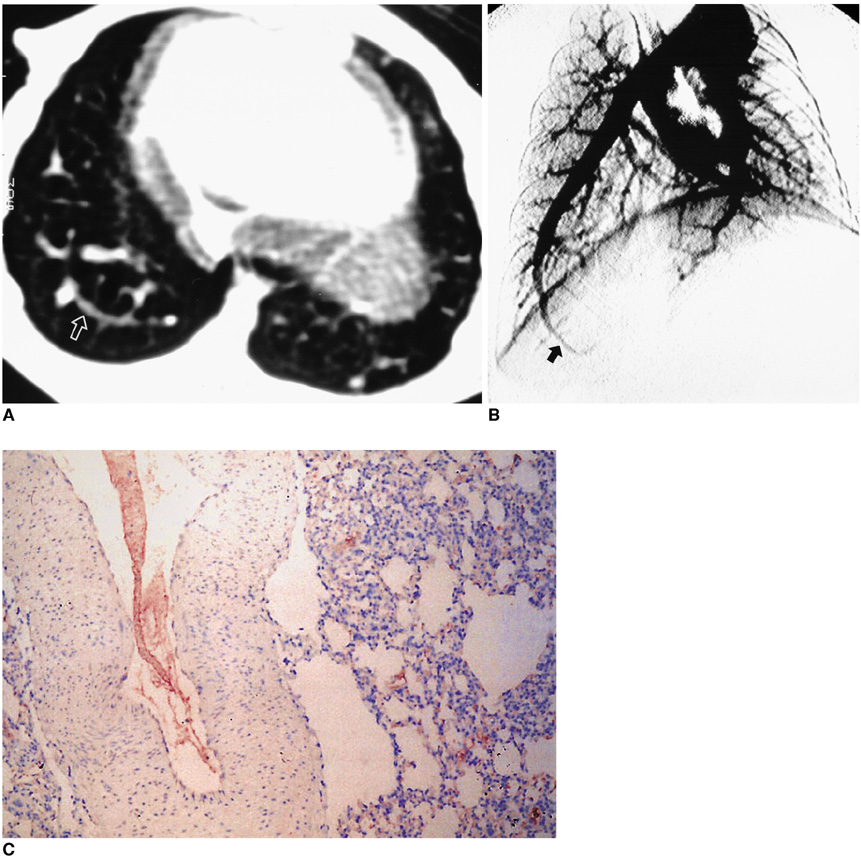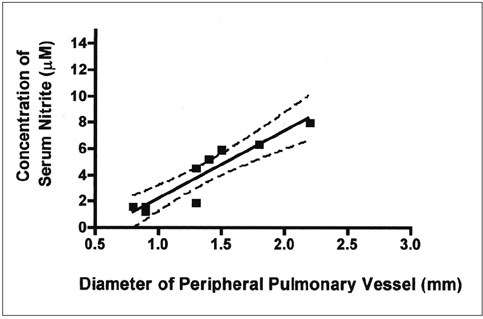Korean J Radiol.
2004 Sep;5(3):149-156. 10.3348/kjr.2004.5.3.149.
Hepatopulmonary Syndrome Induced by Common Bile Duct Ligation in a Rabbit Model: Correlation between Pulmonary Vascular Dilatation on Thin-Section CT and Angiography and Serum Nitrite Concentration or Endothelial Nitric Oxide Synthase (eNOS) 1 Expression
- Affiliations
-
- 1Department of Diagnostic Radiology, Dong-A University College of Medicine, Korea. kinamlee@chollian.net
- 2Department of Biochemistry, Dong-A University College of Medicine, Korea.
- 3Department of Pathology, Dong-A University College of Medicine, Korea.
- 4Department of General Surgery, Dong-A University College of Medicine, Korea.
- KMID: 1118819
- DOI: http://doi.org/10.3348/kjr.2004.5.3.149
Abstract
OBJECTIVE
To investigate the correlation between radiologic vascular dilatation and serum nitrite concentration and eNOS expression in the endothelial cell and pneumocyte in a rabbit model of hepatopulmonary syndrome induced by common bile duct ligation (CBDL). MATERIALS AND METHODS: Thin-section CT scans of the lung and pulmonary angiography were obtained 3 weeks after CBDL (n=6), or a sham operation (n=4), and intrapulmonary vasodilatation was assessed. The diameter and tortuosity of peripheral vessels in the right lower lobe by thin-section CT and angiography at the same level of the right lower lobe in all subjects were correlated to serum nitrite concentration and eNOS (endothelial nitric oxide synthase) expression as determined by immunostaining. RESULTS: The diameters of pulmonary vessels on thin-section CT were well correlated with nitrite concentrations in serum (r = 0.92, p < 0.001). Dilated pulmonary vessels were significantly correlated with an increased eNOS expression (r = 0.94, p < 0.0001), and the severity of pulmonary vessel tortuosity was found to be well correlated with serum nitrite concentration (r = 0.90, p < 0.001). CONCLUSION: The peripheral pulmonary vasculature in hepatopulmonary syndrome induced by CBLD was dilated on thin-section CT and on angiographs. Our findings suggest that peripheral pulmonary vascular dilatations are correlated with serum nitrite concentrations and pulmonary eNOS expression.
Keyword
MeSH Terms
-
Angiography
Animals
Common Bile Duct/injuries
Dilatation, Pathologic/radiography
Disease Models, Animal
Endothelium, Vascular/metabolism
Hepatopulmonary Syndrome/etiology/*metabolism
Ligation
Lung/*blood supply/metabolism/*radiography
Nitric-Oxide Synthase/*metabolism
Nitrites/*blood
Pulmonary Artery/radiography
Rabbits
Research Support, Non-U.S. Gov't
Tomography, X-Ray Computed/methods
Figure
Reference
-
1. Krowka MJ. Hepatopulmonary syndrome. Gut. 2000. 46:1–4.2. Herve P, Lebrec D, Brenot F, et al. Pulmonary vascular disorders in portal hypertension. Eur Respir J. 1998. 11:1153–1166.3. Krowka MJ. Hepatopulmonary syndrome and portopulmonary hypertension: distinction and dilemmas. Hepatology. 1997. 25:1282–1284.4. Luo B, Liu L, Tang L, Zhang J, Ling Y, Fallon B. ET-1 and TNF-alpha in HPS: analysis in prehepatic portal hypertension and biliary and nonbiliary cirrhosis in rats. Am J Physiol Gastrointest Liver Physiol. 2004. 286:G294–G303.5. Zhang XJ, Katsuta Y, Akimoto T, Ohsuga M, Aramaki T, Takano T. Intrapulmonary vascular dilatation and nitric oxide in hypoxemic rats with common bile duct ligation. J Hepatol. 2003. 39:724–730.6. Nunes H, Lebrec D, Mazmanian M, et al. Role of Nitric Oxide in hepatopulmonary syndrome in cirrhotic rats. Am J Respir Crit Care Med. 2001. 164:879–885.7. Lee K-N, Jung W-J, Yoon SK, et al. Correlation of pulmonary vascular dilatation on HRCT to expression of eNOS in a rabbit model of hepatopulmonary syndrome. J Korean Radiol Soc. 2002. 44:475–483.8. Abrams GA, Trauner M, Nathanson MH. Nitric oxide and liver disease. Gastroenterologist. 1995. 3:220–233.9. Chabot F, Mestiri H, Sabry S, et al. Role of NO in the pulmonary hyporeactivity to phenylephrine in experimental biliary cirrhosis. Eur Respir J. 1996. 9:560–564.10. Chang SW, O'Hara N. Pulmonary circulatory dysfunction in rats with biliary cirrhosis: an animal model of the hepatopulmonary syndrome. Am Rev Respir Dis. 1992. 145:798–805.11. Fallon MB, Abrams GA, Luo B, et al. The role of endothelial nitric oxide synthase in the pathogenesis of a rat model of hepatopulmonary syndrome. Gastroenterology. 1997. 113:606–614.12. Luo B, Abrams GA, Fallon MB. Endothelin-1 in the rat bile duct ligation model of hepatopulmonary syndrome: correlation with pulmonary dysfunction. J Hepatol. 1998. 29:571–578.13. Scott VL, Dodson SF, Kang Y. The hepatopulmonary syndrome. Surg Clin N Am. 1999. 79:23–41.14. Fallon MB, Abrams GA, McGrath JW, et al. Common bile duct ligation in the rat: a model of intrapulmonary vasodilatation and hepatopulmonary syndrome. Am J Physiol. 1997. 272:G779–G784.15. McAdams HP, Erasmus J, Crockett R, Mitchell J, Godwin JD, McDermott VG. The hepatopulmonary syndrome; radiologic findings in 10 patients. AJR Am J Roentgenol. 1996. 166:1379–1385.16. Lee KN, Lee HJ, Shin WW, Webb WR. Hypoxemia and liver cirrhosis (hepatopulmonary syndrome) in eight patients: comparison of the central and peripheral pulmonary vasculature. Radiology. 1999. 211:549–553.17. Rolla G, Brussino L, Colagrande P, et al. Exhaled nitric oxide and oxygenation abnormalities in hepatic cirrhosis. Hepatology. 1997. 26:842–847.18. Rolla G, Brussino L, Colagrande P. Exhaled nitric oxide and impaired oxygenation in cirrhotic patients before and after liver transplantation. Ann Intern Med. 1998. 129:375–378.19. Filep JG. Endothelial peptides: biological actions and pathophysiological significance in the lung. Life Sci. 1992. 52:119–133.20. Rodriguez-Roisin R, Barbera JA. Hepatopulmonary syndrome: is NO the right answer? Gastroenterology. 1995. 113:682–684.21. Oh KS, Bender TM, Bowen A, Ledesma-Medina J. Plain radiographic, nuclear medicine, and angiographic observations of hepatogenic pulmonary angiodysplasia. Pediatr Radiol. 1983. 13:111–115.22. Krowka MJ, Dickson ER, Cortese DA. Hepatopulmonary syndrome: clinical observations and lack of therapeutic response to somatostatin analogue. Chest. 1993. 104:515–521.23. Krowka MJ. Clinical management of hepatopulmonary syndrome. Semin Liver Dis. 1993. 13:414–422.
- Full Text Links
- Actions
-
Cited
- CITED
-
- Close
- Share
- Similar articles
-
- Correlation of Pulmonary Vascular Dilatation on HRCT to Expression of eNOS in a Rabbit Model of Hepatopulmonary Syndrome
- Expression of Inducible Nitric Oxide Synthase (iNOS) in the Epithelial Cells of the Distended Bile Duct by the Bile Ductal Ligation
- Impaired endothelium-dependent relaxation is mediated by reduced production of nitric oxide in the streptozotocin-induced diabetic rats
- The dependence of nitric oxide synthase inhibition caused by cigarette smoking extract on the cellular aging of bovine aortic endothelial cells
- The expression of endothelial nitric oxide synthase in the uterus





